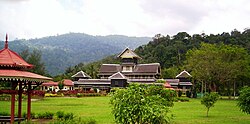
Summary
Seri Menanti (Jawi: سري مننتي; Negeri Sembilan Malay: Soghi Monanti) is a town, a mukim and a state assembly constituency in Kuala Pilah District, central Negeri Sembilan, Malaysia, located 33 km east of the state capital city of Seremban and 14 km southwest of Kuala Pilah. It is the royal capital of the state of Negeri Sembilan and houses the seat of the Yang Di-Pertuan Besar of Negeri Sembilan or Yamtuan Besar, the ruler of the state of Negeri Sembilan.[1] The royal palace is known as Istana Besar (Grand Palace).
Seri Menanti
Soghi Monanti | |
|---|---|
| Bandar Diraja Seri Menanti بندر دراج سري مننتي | |
| Other transcription(s) | |
| • Jawi | سري مننتي |
 The iconic Istana Lama, with the Titiwangsa Mountains rising in the background | |
 Location of Seri Menanti in Negeri Sembilan | |
 Seri Menanti Location of Seri Menanti in Peninsular Malaysia | |
| Coordinates: 2°41′51″N 102°09′30″E / 2.69750°N 102.15833°E | |
| Country | |
| State | |
| District | Kuala Pilah |
| Luak | Adat Circle (main) Gunung Pasir, Jempol, Terachi, Ineh, Ulu Muar (administratively) |
| Founded | circa 15th century |
| As royal capital | 1773 |
| Population | |
| • Total | 1,610 |
| Time zone | UTC+8 (MST) |
| Postcode | 71550 |


The area in which Seri Menanti is located is known as the Adat Circle (Malay: Adat Lingkungan). Seri Menanti also governs the surrounding chiefdoms (known locally as luak) of Terachi, Gunung Pasir, Ulu Muar, Jempol, and Ineh, collectively known as Luak Tanah Mengandung.
History edit
The Minangkabau people moved to the wider area of Negeri Sembilan during the 14th century as part of the Minang practice of merantau. Around the 15th century, they moved further inland from Rembau and explored an area that is known today as Seri Menanti. Among the explorers was Datuk Puteh of Pagar Ruyung. According to legend, they found three stalks of fresh green paddy , and thus Datuk Puteh christened the area Padi Menanti (literally awaiting paddy). Over time, the name changed to Seri Menanti.[2] It is believed that the word "seri" means the Goddess of rice in the ancient Javanese tradition (Javanese: Sri).
Raja Melewar arrived in Negeri Sembilan in 1773, installed and proclaimed as the first Yamtuan Besar in Kampung Penajis in Rembau. He later moved his palace to Seri Menanti which remains the royal town of Negeri Sembilan.
Notable and historical landmarks edit
The official palace of the Yang Di-Pertuan Besar Negeri Sembilan is the Istana Besar. The palace complex consists of the Main Palace, the Throne Room (Balairong Seri), and the Royal Banquet Hall. The Istana Besar was completed in 1932.
The old wooden palace, known as Istana Lama, was built and officiated during the reign of Yang Di-Pertuan Besar Tuanku Muhammad Shah ibni Almarhum Tuanku Antah (who reigned between 1888–1933). It was made in part of Chengal (Penak) wood Neobalanocarpus and ironwood or belian wood Eusideroxylon zwageri and held together using only wooden pegs. The palace took six years to build and was completed in 1908 at a cost of $45,000.00 at that time. The design has subtle hints of Minangkabau architecture; has five levels rising to a height of sixty-seven feet or approximately twenty meters high, and has ninety-nine columns to support the main structure. The Istana Lama was a replacement for the Istana Pulih which was burned down by British soldiers. The drawings and plans for Istana Lama were detailed by Mr Woodford (Public Works Department) based on the designs provided by two local craftsmen, Kahar and Taib.[citation needed] This palace was used until 1932 after which the Yang Di-Pertuan Besar moved to the Istana Besar. The Istana Lama has been designated as a national heritage site and was converted into a Royal Museum in 1992.
Other landmarks include the Seri Menanti Royal Mausoleum.
Surrounding area edit
Among the villages in the area are Kampung Tanah Datar, Kampung Tengah, Kampung Gamin, Kampung Istana Lama, Kampung Sikai, Kampung Buyau, Kampung Batu Hampar, Kampung Mertang Seberang, Kampung Merual, Kampung Galau, Kampung Masjid Terbakar, Kampung Padang Biawas, Kampung Jumbang, Kampong Gunung Pasir and others. A few traditionally styled houses, a derivative of the Minangkabau design Rumah Gadang remain standing around Seri Menanti and in the adjacent villages. A significant portion of the land in Seri Menanti is Malay Reserve and Malay Customary Land (Malay: Tanah Adat).
The Tunku Besar of Seri Menanti edit
The incumbent Tunku Besar of Seri Menanti is Tunku Ali Redhauddin, the eldest son of the Yang Di-Pertuan Besar of Negeri Sembilan Tuanku Muhriz ibni Almarhum Tuanku Munawir. The title of Tunku Besar Seri Menanti is the most senior of the Putera Yang Empat (Four Princes). This is the third time in 120 years that the Tunku Besar Seri Menanti has been appointed.[3]
Heritage edit
In February 2009, the Unity, Culture, Arts and Heritage Minister Datuk Seri Shafie Apdal announced that the Istana Lama Seri Menanti is among ten historical structures in Malaysia gazette as a national heritage, along with Victoria Institution in Kuala Lumpur and The Stadthuys in Malacca.[4]
See also edit
References edit
- ^ "Seri Menanti Palace of Negeri Sembilan" (PDF). Malaysian Australian New Zealand Association. March 2007. Archived from the original (PDF) on 29 August 2007. Retrieved 27 May 2009.
- ^ "The Royal Town of Seri Menanti". Malaysia Story Blog. 31 July 2007. Archived from the original on 26 February 2009. Retrieved 27 May 2009.
- ^ "Tunku Ali appointed Tunku Besar Seri Menanti". Bernama. The Star (Malaysia). 23 February 2009. Archived from the original on 12 February 2011. Retrieved 27 May 2009.
- ^ "Heritage status for 10 sites". The Star (Malaysia). Archived from the original on 18 February 2009. Retrieved 15 February 2009.
2°42′N 102°10′E / 2.700°N 102.167°E


